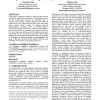Free Online Productivity Tools
i2Speak
i2Symbol
i2OCR
iTex2Img
iWeb2Print
iWeb2Shot
i2Type
iPdf2Split
iPdf2Merge
i2Bopomofo
i2Arabic
i2Style
i2Image
i2PDF
iLatex2Rtf
Sci2ools
SMA
2003
ACM
2003
ACM
Graph based topological analysis of tessellated surfaces
In this paper a graph-based method is presented which not only characterizes topological classification of the tessellated surfaces but also simultaneously generates the substantial circles or generators on the surface. Canonical polygons cannot always be mapped back to the original surface in terms of the edges of the given triangles. Hence, instead of applying canonical transformation to the initial "word", an associated graph is constructed using the unique vertices in the word. The graph is then decomposed into its constituent loops and paths. Based on the type of edges present, the loops are classified into three types. The number of loops of each type in the graph is then used for counting the rank or genus and classification of the given surface as being open or closed, orientable or non-orientable. The image of the loops and paths on the original surface give the substantial circles and arcs on the surface respectively. Categories and Subject Descriptors I.3.5 [Compu...
| Added | 05 Jul 2010 |
| Updated | 05 Jul 2010 |
| Type | Conference |
| Year | 2003 |
| Where | SMA |
| Authors | Tula Ram Ban, Dibakar Sen |
Comments (0)

